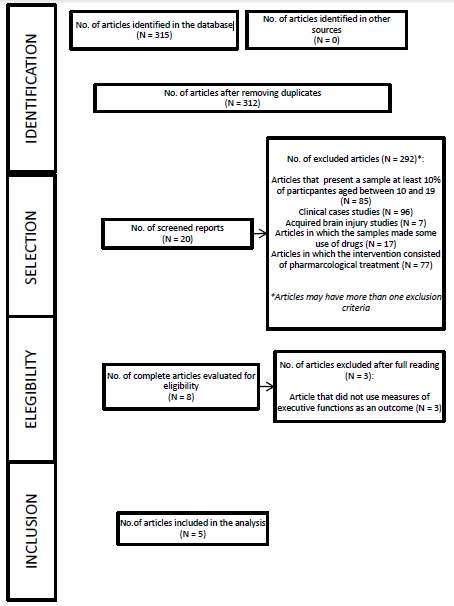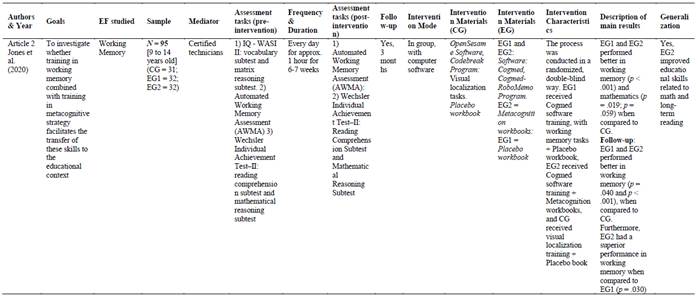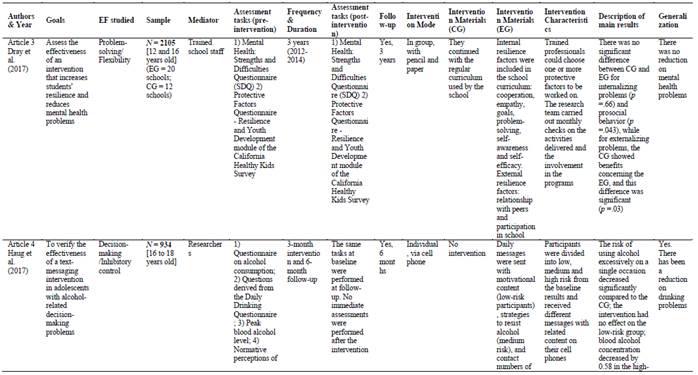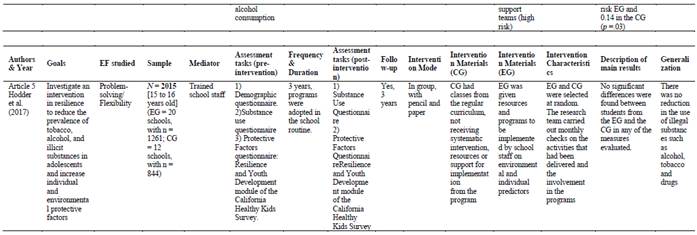The World Health Organization defines adolescence as the period of life that begins at the age of 10 and ends at 19 (World Health Organization, 1986). During this period, compared to childhood, decisions tend to be more independent of adult advice and, at the same time, more susceptible to peer influence (Andrews et al., 2021; Blakemore & Robbins, 2012; Laursen & Veenstra, 2021). Besides, the individual may have difficulties correctly judging high-risk situations, including making plans and balancing short-term reinforcements with long-term goals (Burnett et al., 2011; Laursen et al., 2020). This is a relevant aspect, since high-risk decisions in adolescence may have serious consequences, which can lead to problems and even the death of the adolescent as a result, for example, of reckless driving and excessive use of drugs and alcohol (Blakemore & Robbins, 2012; Evans et al., 2016).
Research has focused on studying the relationship among the maturation process of the prefrontal cortex, overactivation in regions of the nucleus accumbens and the ability to judge in difficult life situations during adolescence (Blakemore & Robbins, 2012; Pei et al., 2020). The functioning of the prefrontal cortex is related to cognitive analysis, abstract thinking, moderation of correct behavior in social situations, control of inappropriate behaviors and mental organization to achieve specific goals. Such conditions are called executive functions (EF) and have been treated as essential for an individual's mental health, educational success, and cognitive, social and psychological development (Diamond, 2013; Zelazo et al., 2016). Thus, EF refers to a set of neurocognitive processes involved in the ability to set goals and organize steps to achieve them, recruiting the essential components of working memory, inhibitory control, and cognitive flexibility to solve problems (Diamond, 2013; Friedman & Miyake, 2017; Miyake & Friedman, 2012).
Of the three fundamental skills associated with EF, working memory comprises the ability to store and manipulate information for a short time (Baddeley & Hitch, 1994). The inhibitory control component is associated with the individual's ability to inhibit an automatic response, resist and control an initial impulse. On the other hand, cognitive flexibility refers to adjusting behavior to environmental changes and analyzing elements from different perspectives, allowing the individual to adapt to different situations and mental demands (Dajani & Uddin, 2015; Diamond et al., 2005).
Additionally, besides the basic skills components of EF, these can be analyzed in light of the type of content involved, being divided into cold and hot EF (Zelazo & Carlson, 2012). Both cold and hot EF refer to intentional and goal-oriented processes, but they differ in terms of the level of involvement of emotional and motivational processes (Zelazo & Carlson, 2020).
Cold EF relates to the individual's ability to deal with cognitive content, with little emotional or motivational involvement, including strategic action planning, organization and goal setting, behavior monitoring, problem-solving, inhibition of behavior and irrelevant cognitions, and flexibility of thoughts (Fuster, 2002; Peterson & Welsh 2014; Salehinejad et al., 2021; Zelazo et al., 2003). Hot EFs consist of such processes in situations with relevant emotional or motivational involvement (Salehinejad et al., 2021; Zelazo & Carlson, 2012).
EF have a long course of development, starting in early childhood and progressing into early adulthood. In adolescence, although some basic skills related to cognitive content are already well developed, there is worse performance when motivational and emotional content are involved (Hooper et al., 2004; Poon, 2018). There is evidence that hot EF's developmental trajectory is longer than cold EF's (Peterson & Welsh, 2014).
Although EF is still developing in adolescence, especially in its early years, there is evidence that adolescents can learn to avoid risky behaviors (Romer, 2010). Randomized clinical studies have shown benefits of EF stimulation in typically developing adolescents, resulting in improved ability to make more assertive decisions (e.g., Knight et al., 2015). Educational interventions have also been commonly implemented to prevent maladaptive behaviors that result in long-term negative consequences (Yeager et al., 2018). Many of these interventions are based on the assumption that more tailored and planned behaviors can be achieved when adolescents can better identify high-risk situations, develop the skills to select healthier goals and raise awareness of social values related to healthy behavior, i.e., when there is hot and cold EF stimulation (Durlak et al., 2011; Yeager et al., 2015).
Therefore, through specific interventions, it is possible to promote hot and cold EF in adolescents, even during typical development, given that such functions are not yet fully mature. The promotion of EF in adolescents can bring academic, functional, and social benefits in the short or long term, reducing risk behaviors that can harm them during adolescence and adulthood (Becan et al., 2015). Therefore, a systematic review is necessary to provide an overview of empirical studies that have researched stimuli at this stage of development, which will help identify more effective intervention forms. To our knowledge, no other systematic review has sought to identify EF intervention programs in typical adolescents. Thus, the present study aims to identify, through a systematic review, which interventions in executive functions have been studied in typical adolescents, including hot and cold executive functions, seeking to determine the effects of these interventions in this segment.
Method
This systematic review study was conducted according to the Preferred Reporting Items for Systematic Reviews and Meta-Analyses (PRISMA) method (Moher et al., 2009). The database used was Pubmed, searching for articles on cold or hot executive functions interventions in typically developing adolescents between 2015 and 2020. The following keywords and syntax were used: Rehabilitation OR habilitation OR Intervention OR stimulation OR teaching AND adolescent OR adolescents OR teenager OR teenagers OR juvenile AND executive dysfunctions OR working memory OR inhibition OR behavioral regulation OR self-control OR delay gratification OR mindfulness OR attention control OR emotion regulation OR self-regulation OR planning OR planning action OR updating OR attention OR shifting OR cognitive flexibility OR problem-solving OR decision-making OR executive function OR social skills AND typical OR typically.
Inclusion criteria were: 1) experimental studies (randomized or not) of intervention in at least one EF skill; (2) that use a sample of typical adolescents; (3) published in scientific journals; (4) written in Portuguese, English or Spanish; (5) articles published between 2015 to 2020. The following were excluded from the research: (1) articles that present a sample of at least 10% of participants aged under 10 and over 19; (2) clinical case studies; (3) studies with samples of participants who had acquired brain injury; and (4) studies that measured the effects of pharmacological treatments.
After the research carried out in PubMed, all duplicates were excluded by the State of the Art through Systematic Review (START) program developed by São Carlos Federal University (Universidade Federal de São Carlos (UFSCar)). Then, the abstracts were analyzed, and the inclusion and exclusion criteria were applied using the double-blind review method by four judges in psychology. Finally, after selecting articles by four independent judges, the consensus was reached after consulting a fifth judge, a neuropsychology specialist. The full texts were then read, again applying the inclusion and exclusion criteria. After selecting the articles, the following items from the full text were analyzed: (1) Objectives; (2) Method; (3) Results.
Results
As shown in Figure 1, from the search with the described syntax, 315 articles were identified in the database. At first, 3 duplicates were excluded, leaving 312 articles. Then, 292 were excluded after analyzing the title and abstract information based on the criteria mentioned above. Among the remaining 20, according to the judges' analyses, 15 were excluded for the following reasons: (1) they sought to verify the effects of stimulation on the adolescents' communication; (2) semi-experimental studies that searched to verify the effects of stimulation in decreasing depression symptoms, without mentioning any cognition related to EF; (3) interventions focused on decreasing pain symptoms; (4) samples with traumatic brain injury; (5) interventions focused on preventing belief formation and pseudoscience.
Table 1 t2 t3 t4 contains the descriptions of the five studies selected for the systematic review. For each study, the following were characterized: (1) Objectives; (2) Method (sample, assessment tasks, frequency and duration of intervention, post-assessment tasks, intervention materials); and (3) Results. The numbering of the articles shown in Table 1 will present the results and discussion below.
All studies aimed to verify the effectiveness of an intervention in different EF constructs, namely: self-regulation aspects, related to the time spent reading words without showing signs of distraction (article 1, as numbered in Table 1); working memory, with generalization to educational competencies (article 2); problem-solving, as a protective measure for mental health, resilience towards mood disorders, associated with decision-making, (3); decision-making, related to reducing the excessive use of alcoholic beverages (4); and problem-solving, as a measure to reduce the use of tobacco, alcohol and illicit substances (5).
Four articles used samples only from adolescents (2, 3, 4, 5), while a single study mixed adolescents and adults (1). The age of participants ranged from 9 to 18 years old, including female and male. The assessment tasks varied among questionnaires developed by the researchers, with questions that assessed alcohol abuse, resilience and substance use (3, 4, 5); traditional test measures (2); and word reading task, being evaluated the attentional focus time in the execution of the activity (1).
Among the studies, three had the group intervention modality (1, 3, 5), and three were mediated by the researchers themselves (1, 2, 4). As can be seen in Table 1, the interventions had the following focuses: intervention to promote self-regulation concerning the ability to spend more time on educational tasks; cognitive working memory training for educational benefits, every day for six weeks (2); resilience towards mood disorders, associated with decision-making; decision-making associated with alcohol consumption; and decision-making related to psychoactive substance use.
The intervention models varied considerably from one study to another, as the focus also differed among them. Only one research included cognitive training using software with generalization analysis for educational skills (2); two studies made curricular adaptations with the preparation of school employees (3.5); while the others used advice (1) and support messages by cell phone (4) for the participants.
In article 1 sought to verify whether giving advice would be more effective than receiving advice in the self-regulation and self-motivation process to spend more time on educational tasks. The experimental group was trained to provide previously structured written advice to the control group, which only received the advice. The advice was, “I feel I don't do my best on educational assignments; when they ask me to check my done activity, I don't feel motivated. How do you feel about situations like these?”. Other letters said, “You must always try your best” and “Don't give up quickly on the task, pay attention to what you are doing”. Control group participants only read the motivational advice given in a standardized way by the experimental group. The primary outcome was the average number of minutes students spent studying online vocabulary after the intervention. A timer tracked the number of minutes each student spent in the program during the two weeks prior to the intervention and the four weeks after the end of the intervention. This study showed that the experimental group, which gave the advice, focused more on online vocabulary activities than the control group, which only received the advice through letters. This gain was significant at the end of four weeks after the intervention (p = .005).
On the other hand, in article 2, the Cogmed software was used for the intervention, consisting of a battery of 11 short-term memory and working memory tasks, with visual and verbal stimuli and a running game as a bonus at the end of the 11 tasks. Initially, they had some training items and involved: remembering a sequence of places in an order; following and remembering a series of movements of objects or places; rearranging and recalling a sequence of locations; remembering a sequence of digits in reverse order; recognizing a series of letters. There was also a metacognition workbook intended to train three skills: planning, monitoring, and evaluating. In the beginning, participants completed three reflection tasks that encouraged them to think about their thinking. Then, they were introduced to planning, monitoring, and evaluating specific metacognitive skills used for self-motivation and attention (“refocus”). The results revealed a significant change in working memory (p < .001) and marginally substantial for mathematics (p= .059) in the intervention group compared to the control group.
Two other studies (3, 5) dealt with the same research, conducted over three years, with accommodations in the students' school program content, with each study analyzing specific outcomes. One study analyzed the enhancement of resilience and mental health (3), and the other sought to reduce the use of illegal substances by adolescents (5). The intervention was given by the school team itself and was conducted at three levels: 1) curriculum, teaching and learning, which included: a) age-appropriate classes (minimum of 9 hours) on protective factors, which took place in different curriculum areas, such as English; Mathematics; Science; History and Geography, and/or Personal Development, Health and Physical Education; b) non-curricular programs (9 hours), aimed at promoting protective factors outside the classroom (for example, the Queensland University of Technology Resourced Adolescents Program, 2013), and c) additional program targeting protective factors for Aboriginal students; 2) ethics and environment, which included rewards and recognition programs, peer support or peer mentoring programs, anti-bullying programs, training programs, additional training programs, leadership, mentoring and cultural awareness for Aboriginal students; and 3) partnerships and services, which included: strategies to increase parent involvement in the school (e.g., school events and effective parent communication strategies), and engagement of other sectors of society in the school. The control group, in both studies, remained with the same curriculum. The studies did not show significant changes for the group that received the interventions in either of the two articles; on the contrary, in one of them, the control group showed significant improvements (p = .03) concerning the experimental group in terms of a decrease in externalizing behaviors (3).
The intervention of article 4 focused on sharing daily text messages to decrease alcohol use. Participants were classified into three levels regarding risk behaviors, specifically alcoholic beverages: lower, medium, and high risk (daily alcohol consumption risk). Specific messages were sent to each group over three months. Thus, the group classified as low risk received daily messages on their cell phone with motivation to maintain low-risk levels of alcohol consumption and strategies to resist alcohol in different situations, using personal data from a previously answered questionnaire. The medium-risk group received daily messages with the contents of the low-risk group and, additionally, information on alcohol-related problems, maximum blood alcohol concentration and related risks using data on sex, body weight, and the maximum number of drinks on a single occasion would be feasible. Participants in the high-risk group received all the contents of the previous groups, plus information about places for help that could be sought. The study showed significant differences among the groups, with participants who underwent the intervention having a more substantial decrease in alcohol use than the control group (p = .03).
Discussion
The present article sought to identify studies that conducted EF stimulation programs in typically developing adolescents through a systematic literature review. It is essential to emphasize the relevance of interventions in typically developing adolescents. One may question why there is a need to promote EF if such individuals do not have deficits in these functions. As a reflection on this issue, it should be remembered that EF are still developing during adolescence, especially hot EF. Therefore, although typical adolescents do not have a specific commitment to EF, adolescence itself is already a critical period because the individual, still without full development of EF, has more autonomy and is more exposed to decision-making, being more prone to peer influence and risk behaviors, which can have significant negative consequences for adolescents. Therefore, programs that promote their total development are welcome and can bring short and long-term educational, functional and social benefits, being considered protective factors against possible consequences of decision-making that harm adolescents (Becan et al., 2015).
In the present review, studies with interventions in hot EF and/or cold EF were included. Of the 312 articles initially located in the search, five articles were selected. The small number of studies is already the topic of discussion. It is mainly for two reasons: most interventions aimed at adolescents were drug-based, and many articles addressed clinical cases (n = 96), an exclusion criterion for the systematic review.
Considering the complexity of EF, the search performed covered aspects related to the hot and cold components of these functions. Hot EFs, as previously defined, refer to skills in the socio-emotional and motivational domain. Among the articles selected here, it is observed that three focused more specifically on hot EF, as they aimed to promote externalizing, prosocial and internalizing behaviors associated with decision-making and problem-solving (3, 4, 5).
On the other hand, cold EF is associated with cognitive domains. This systematic review revealed a study that sought to enhance working memory conditions (article 2). The review also revealed an article in which both hot and cold EF were promoted (article 1). There was intervention on self-regulation and motivation aimed at learning conditions and attentional focus during reading.
Comparing the effects of interventions, it is observed that from the three studies focused more specifically on hot EF; only one revealed statistically significant results. Thus, the two studies whose interventions were carried out through curricular adaptations focused on hot EF stimulation did not obtain substantial results (articles 3, 5). In contrast, the intervention made directly through text messages showed a considerable gain in the experimental group concerning the control group (article 4). In the study that more specifically addressed cold EF (article 2), there were statistically significant gains for the group that received intervention through the Cogmed software for working memory stimulation (2). In article 1, which addressed both EF, there were also statistically significant gains for the group that advised how to stay more attentive in reading tasks.
Despite the small number of articles analyzed limiting the interpretation of the data, it is observed that the two studies in which there were no gains for the intervention group were of specific stimulation in hot EF. Interventions in these functions may be less effective or may require more time. A previous review study with a sample of children with brain damage points out that hot EFs need more time to be worked on than cold EF interventions (Chavez-Arana, 2018). Furthermore, research indicates that hot EF interventions have not shown benefits on internalizing and externalizing behavior problems (Bond et al., 2004; Fitzpatrick et al., 2009; Melnyk et al., 2013; Possel et al., 2004; Roberts et al., 2010; Sawyer et al., 2010; Tak et al., 2014). However, despite still limited results in interventions in hot EF, it is in adolescence that the peak of gray matter volume development in the prefrontal cortex is reached. It is sensitive not only to internal conditions but also to environmental conditions of stimulation (Crone & Dahl, 2012). Therefore, it is essential to continue investing in research to develop and evaluate interventions promoting hot EF.
Although research indicates that prolonged intervention time results in greater adherence to treatment and benefits of the strategy (Diamond & Ling, 2020), this was not what the review showed. Two articles selected here (3, 5) had an intervention over three years and did not reveal significant effects. It is noteworthy that both refer to a single study, and each article verified the effectiveness of the intervention on different outcomes. It is essential to describe some limitations of this study. The measurement of results was carried out solely by self-report scales, which may have contributed to a bias on mental health symptoms linked to externalizing, internalizing and prosocial behavior problems. According to Salomone et al. (2020), reports from questionnaires and scales are important in the individual's self-assessment, but they may reflect socially desirable behavior rather than actual behavior. Another critical point is that the entrance and exit of students in the school were not controlled, so new students were admitted in this process, and some research participants left the school in question. Thus, articles 3 and 5, despite referring to a prolonged intervention, did not reveal significant effects.
Some possible strategies to increase the effects of interventions have been suggested in the literature. Evidence shows, for example, that including parents in the stimulation process can enhance intervention outcomes, improving behavior through the application of educational methods to broaden the behavioral repertoire and redesign the context (Monger et al., 2002; Ylvisaker & Feeney, 2009). This is especially relevant in the case of behaviors linked to hot EF, as these can be more clearly related to unfavorable and dysfunctional home environments and, therefore, institutional accommodations may only bring short and long-term benefits (Zelazo et al., 2016).
Only one study (article 1) proposed an intervention that contemplated hot and cold EF, but still without a clear operationalization of the three essential components of cold EF, namely, working memory, inhibitory control and cognitive flexibility. Studies with humans and animals with brain lesions suggest a dissociation between hot and cold EF (Zelazo & Carlson, 2012). That is, damage to hot EF can occur in the absence of damage to cold EF and vice versa. Although research portrays this functional separation between them, other studies suggest that the two types of EF work together as part of a general adaptive functioning (Hongwanishkul et al., 2005; Zelazo et al., 2010). Considering that hot and cold FE, although dissociated, work together as a great orchestra, further research should focus on studying combined hot and cold EF stimulation analyzing short and long-term effects since, in general, one stimulation can potentiate the effect of the other. In fact, in article 1, significant gains were verified in the experimental group compared to the control, increasing the time spent on reading tasks.
The present study has some limitations. First, the study relied only on a search in the PubMed database. Despite the importance of this base for research in neuropsychology, it is noteworthy that other bases could have increased the number of articles. As the PubMed database is intensely focused on health studies, there may be a concentration of studies with individuals with acquired brain damage. Searching other databases could help to locate articles with participants with neurotypical development. A second point to be discussed, also related to the study method, is the search restriction to articles published in the last five years. It is possible that searching with an extended publication period could bring up a more significant number of studies.
Despite these limitations, this study presents original information by synthesizing studies with interventions on EF in typically developing adolescents. The lack of research in this area was evident. Taking into account that at this stage of development, the individual is more likely to emit risky behaviors compared to adults, especially under the influence of their peers, it is of fundamental importance to conduct studies with interventions to minimize the harmful effects of the search for risky situations which may result from a still partial development of hot and cold EF in adolescence.




















